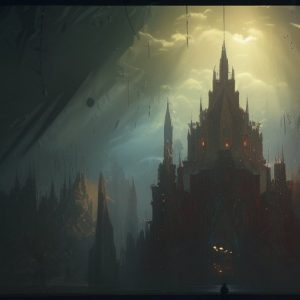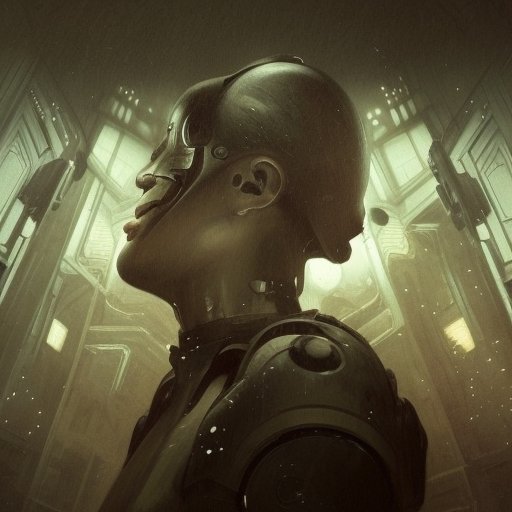
Get ready for an adventure as we explore the power of imagination triggering in sci-fi. Imagination is the gateway to the future, and we’re taking a deep dive into the world of imagination triggers. Join us as we look at the roots of imagination triggering, and how sci-fi has been a driving force throughout history. We explore how augmented reality and neurotechnology are now paving the way for the next generation of imagination triggers. And, of course, we’ll show you how films and TV shows can also trigger those same imaginative brain cells. Don’t miss out on our journey into the past, present, and future of imagination triggering.
I. Introduction
Greetings, fellow adventurers of the universe! Today, we embark on a mission to explore the wondrous terrain of imagination triggering. How do we turn mere thoughts into a world of endless possibilities? The answer lies within the depths of our imagination, patiently waiting to be unlocked.

In today’s world of modern technology, the notion of imagination is often brushed aside. People tend to prioritize logic and reason over creativity and imagination. However, what many fail to realize is that imagination is integral to problem-solving, social interaction, and emotional wellbeing. From the pages of our favorite sci-fi novels to the latest augmented reality technologies, imagination triggers have been utilized to spark the flame of creativity.
Through the power of thought-provoking narratives and awe-inspiring visuals, science fiction has become one of the most captivating forms of media. It enables us to explore new worlds, encounter unimaginable life forms, and most importantly, it triggers our imagination. Science fiction has encouraged us to think beyond the ordinary, and this has played a significant role in shaping our modern world.
Nowadays, with advancements in technology, we have tools that can take imagination triggering to the next level. Augmented reality, neurotechnology, and film are just a few examples of mediums that enable us to experience imagination in entirely new ways. By using these tools, we can explore new worlds beyond the pages of books and immerse ourselves in an entirely different universe.
In the rest of this article, we will take a closer look at these various imagination triggers and how they work. We will delve into the depths of the human mind and explore how imagination can be utilized to unlock unexplored potential. So hold on tight, dear readers because we are about to embark on a journey beyond the limits of what we know.
II. The Power of Sci-Fi
Ah, science fiction, the cornerstone of imagination triggering. From the far reaches of space to alternate dimensions, science fiction literature, and media have captured the hearts and minds of people for decades. But, what makes sci-fi such a powerful tool for imagination triggering?

At its core, science fiction often presents us with stories about worlds vastly different from our own, filled with strange creatures, and wild technologies. The very act of reading or watching these stories requires us to use our imaginations to envision the world beyond the page or screen. By doing so, we are expanding our mental capacity and exploring new ideas and concepts that were previously unknown to us.
Furthermore, sci-fi often tackles big ideas and themes that challenge our preconceived notions of the world. These ideas can range from explorations of futuristic technologies to societal issues like artificial intelligence, social inequality, and the consequences of unchecked power. By experiencing these narratives, we are encouraged to think outside of the box and to contemplate what the future may hold.
The power of sci-fi also lies in its ability to inspire invention and innovation. Many of the technologies we have today were once considered the stuff of science fiction. From cell phones to space travel, much of what we have today started as just an idea in the mind of a sci-fi author. By presenting us with a futuristic world, science fiction encourages us to think about how we can make that world a reality.
III. Augmented Reality and Imagination Triggers
You won’t believe your eyes when you see the true potential of augmented reality (AR) and imagination triggers! The power to experience a whole new world by enhancing the physical environment is something straight out of science fiction. Augmented reality is the perfect example of how technology can elevate our imagination to new heights.

AR works by overlaying digital content onto the real world. This can be done through various devices such as smartphones, tablets, and wearable technology. With AR, you can see things that aren’t physically present in the real world, and these things can trigger the imagination in incredible ways.
One of the most significant advancements in AR is the ability to create unique experiences through immersive storytelling. Picture this: you’re walking through a museum and suddenly you see the art come to life. You hear the stories behind each piece, see the colors explode into the air, and feel like you’re part of that painting. This kind of experience has been the dream of many artists, and now it’s possible with AR.
But the world of AR and imagination triggers goes beyond just entertainment. We can use these tools to alter our perception of reality completely. For instance, AR can be used for training purposes allowing individuals to experience situations that would otherwise be too dangerous or inaccessible to them.
Furthermore, AR can be utilized to bridge the gap between the digital and physical world, like never before. By adding a digital layer, we can interact with our surroundings in unprecedented ways. This opens the door to entirely new possibilities and experiences that were once impossible to conceive.
IV. Mind Games
Step right up, dear readers, and prepare to have your mind blown by the latest in imagination-triggering technology! Neurotechnology, the science of manipulating the brain to enhance our abilities, has opened the doors to a whole new frontier of imagination triggers. By mapping neural pathways, researchers have found ways to get into the very workings of the human mind – and manipulate them!

One example of this is the use of transcranial magnetic stimulation (TMS), a noninvasive method of stimulating brain activity. By applying targeted magnetic fields, TMS can activate specific areas of the brain, resulting in heightened imagination and creativity. Imagine being able to turn up the volume of your imagination with just a flick of a switch – sound too good to be true? Well, it’s not just science fiction – it’s real!
Another technique that is rapidly gaining popularity is neurofeedback. Through real-time monitoring of brainwave activity, individuals can learn to consciously control their brain function. With this method, people can learn to enter into specific brainwave states, such as theta waves, which are linked to creativity and imagination. The brain becomes a canvas, and the user becomes the artist, using skillful brushstrokes to create a masterpiece in their mind’s eye.
But it’s not all rainbows and unicorns – with great power comes great responsibility. The same technology that can expand our imagination can also be used for more nefarious purposes. With the ability to manipulate brain function comes the possibility of corruption and control. We must tread carefully into this brave new world of neurotechnology and ensure that the ethical implications are considered.
V. Beyond the Page
Lights…Camera…Action! If books are the bread and butter of imagination triggering, then films and TV shows are the icing on the cake. There’s something to be said about visually experiencing a story, and this medium takes imagination to a whole new level.

From classic sci-fi flicks like Star Wars to modern blockbusters such as The Martian, films and TV series are known to capture the essence of imagination in ways that books can’t replicate. With the help of advanced computer graphics, we can witness the impossible come to life right before our very eyes.
One of the most notable examples of how film can trigger the imagination, is the Star Wars franchise. From the epic battles to the unique creatures and humanoids that inhabit various planets, it’s no surprise that fans have been captivated by this series for over 40 years. The imaginative landscapes of George Lucas’ vision have inspired generations of filmmakers, artists, and sci-fi enthusiasts.
In recent years, the rise of TV series has only added to the power of imagination. Shows like Stranger Things and Black Mirror have captivated audiences with their unique, imaginative storylines. These stories open up a world of possibilities, making us think about the future, the past, and the limitless world of what-if scenarios.
VI. Tales from the Past
Ah, fellow sci-fi enthusiasts, let me take you on a journey through time to explore the power of classic science fiction in imagination triggering. Before we had the technology we have today, we had the written word, and works of literature were the driving force behind imagination triggers.

Take for example the works of Frank Herbert and his masterpiece, Dune. This literary classic transported us to a distant planet, where spice mining, intergalactic politics, and religious fervor ruled the day. It was a universe unlike anything we had ever encountered before, and it sparked the imagination of millions of readers worldwide. Even to this day, Herbert’s epic story continues to inspire and captivate us.
And what about Ender’s Game, our beloved sci-fi tale of humanity’s struggle for survival against an alien threat? Or Ray Bradbury’s Fahrenheit 451, a story that warned us of the dangers of censorship and conformity? These classics, and many others like them, have left an indelible mark on the world of science fiction and imagination triggering as a whole.
But it’s not just the content of these classic works that triggers the imagination. It’s the way these stories are told, the experiences they provide, and the emotions they stir within us. A skilled storyteller has the power to transport us to worlds beyond our imagination, to make us feel and see things that we never thought possible.
It’s easy to dismiss classic science fiction as “old news” or irrelevant in today’s technology-driven world. But the truth is that these stories have laid the foundation for today’s imaginative works, and they continue to inspire new creations even now. So the next time you pick up a classic sci-fi novel, take a moment to appreciate the impact it has had on our collective imagination.
VII. Conclusion
And so, our adventure comes to a close, but the journey towards unlocking the true potential of our imaginations is far from over.

Through the power of science fiction, augmented reality, and neurotechnology, we have been given the tools to explore imaginary worlds beyond our wildest dreams.
But we must remember that imagination is not just a tool for entertainment, but also an essential aspect of human growth and development. It allows us to explore new solutions to existing problems and pave the way for a better tomorrow.
As we move further into the future, we must continue to find new ways to utilize imagination triggers to unlock previously unexplored potential. By blending imagination and technology, who knows what new worlds we may discover or what new possibilities we may create.
In a world that often values logic over creativity, let us remember to embrace our imaginations and see the beauty in the impossible. As science fiction writer Ray Bradbury once said, “We are an impossibility in an impossible universe.” It is up to us to use our imaginations to defy the impossible and create a better future.
Together, through the power of imagination, we can shape our destiny and explore the unknown. So let us continue to trigger our imaginations and boldly go where none have gone before. The universe is waiting.






